![]()
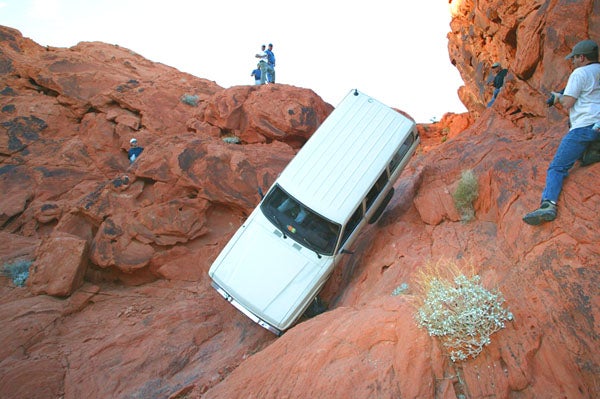
Even with rocks, snow, or mud, four wheeling just isn’t the same if you are on flat land. Mountains, dry waterfalls, and sheer cliffs add to the terrain and are often our destination when we are behind the wheel. Not all hills are created equal though. Some are looser or steeper than others and may pose a problem for the unprepared. The following tips will help you the next time you encounter a big hill or drop off.
Maintain Traction- The biggest mistake we see new drivers make when attempting steep obstacles is to mash the gas when they get frustrated. While this might please nearby spectators, it rarely results in conquering the obstacle. Instead of stabbing the throttle, back down and analyze the obstacle. Try a slightly different line or a little more speed. Spinning tires don’t provide nearly as much traction as tires that are stuck to the ground.
Stay Off The Brakes- When descending a steep slope, the natural reaction is to hit the brakes. Often times this causes the tires to lose traction and the vehicle to slide wherever gravity and fate take it. With a manual transmission, it is easy to use compression braking to hold the vehicle back and keep it from going too fast. With an automatic this is more difficult, but you can still shift the transmission manually into a lower gear. If you do start sliding, point the front tires downhill and accelerate to straighten the vehicle out. It might seem counter-intuitive to hit the gas when you are headed downhill out of control, but this is the best way to regain traction and control.
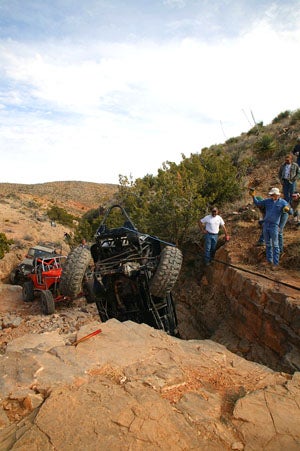 |
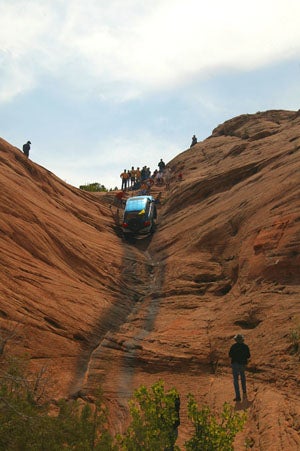 |
Without a winch hooked up, this climb would have resulted in a certain rollover for the driver of this TJ. Better safe than sorry. |
Moab’s famous slickrock offers unmatched traction. Spin a tire on an obstacle like Hell’s Gate and you are likely to dump your vehicle on its side… or worse. |
Chose The Right Gear- The key to making it up (or down) excessively steep terrain is to pick the right gear. Too high of a gear and you risk stalling; too low of a gear and you might not have the speed to keep your vehicle moving. You want to have enough momentum to make it to the end of the climb without having to shift in the middle of the obstacle.
This is generally easier in vehicles with more gearing options, such as dual transfer cases, or with automatics, since the torque convertor provides a safe margin for error. Note that some automatic transmissions can starve for fluid and slip on steep slopes when all of the fluid rushes to the rear of the case. A deep pan that provides more capacity can help overcome the problem.
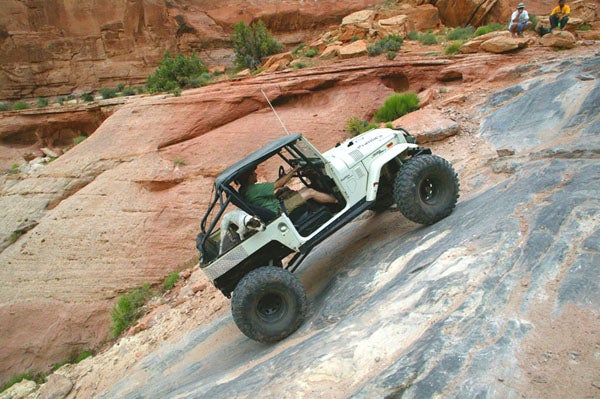 |
Make sure to tie down everything that might come loose in a steep situation. This dog is likely to become a dog-to-ground missle if the driver has to make sudden maneuvers. |
Stow Your Gear- We aren’t talking about transmission or transfer case gears here. We are talking about your ice chest, Hi-Lift jack, tools, and all of the other things that you carry with you on the trail. These items can become deadly missiles during sudden weight transfers. Make sure that anything you wouldn’t want hitting you in the head is safely stored and strapped down as soon as you lock the hubs and air down your tires.
Cage It- A rollcage is a wise investment for any terrain, but none more so than steep ascents and descents. The potential for a rollover is much greater, and a rollcage is the best way to protect occupants from potential harm. Cages should be constructed of HREW, DOM, or chromoly steel and tie into the cab or frame in at least four locations. Tying into the frame is more complicated, but stronger than just bolting the cage to the body. If you do connect the cage to the body, make certain that the plates you use to sandwich the body are different sizes on top and bottom to keep them from punching through the floor. Tying the seats and harnesses into the cage makes for an even safer structure, but make sure that you do both the seats and the harnesses at the same time. You don’t want your seats to go one direction and your harness to go another direction in a violent rollover.
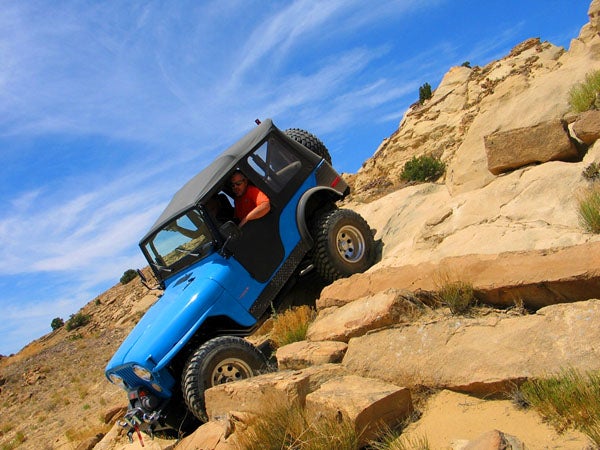 |
Short wheelbase vehicles like this CJ-5 are very maneuverable, but they can make for nerve wracking descents. Added wheelbase provides stability in situations like this. |
Longer Wheelbase- Putting a Jeep flat fender and a new Wrangler Unlimited on the same climb will produce drastically different results. The flatfender might end up on its lid in places where the Unlimited would not even break a sweat. The extra three feet of wheelbase means that on many obstacles, the front tires are already up before the rear tires reach the ledge. Similarly, on descents there is less chance the rear of the vehicle will try to pass the front. The tradeoff is maneuverability. The flatfender will eat the Unlimited’s lunch in tight terrain and sharp objects that require a good breakover angle.
Check Ahead- If you cannot see the other side of the hill or obstacle you are about to attempt, it is wise to get out and check ahead to make certain that it is safe. Once you are belted in and behind the wheel it is too late to worry about what is on the other side or if there is traffic coming the other way down the trail.
Another reason to check ahead is to survey the terrain. Once you start up the climb, it is likely that all you will see is hood and sky. Enclosed trucks and SUVs provide worse visibility than Jeeps, but regardless of what you are driving it is wise to look ahead. Like a chess match, you need to plan several moves ahead in steep terrain.
 |
Many competition buggies use winches to compress their long travel suspensions for steep obstacles where massive articulation is not needed. Note the winch cable strapped to the front axle of this buggy. |
Use The Winch- If you think that there is a chance you might roll backwards off a steep ascent, or forwards off of a descent, hook up the winch to be safe. It is better to have the winch attached and not need it than to have to fumble to find the controller and unspool the cable in a precarious situation. Just remember not to run the cable over as you make forward progress.
Some rockcrawlers with supple, long travel suspension uses winches to preload the suspension for steep ascents (front suspension) and descents (rear suspension). If you already have a winch, it is easy enough to suck down the front end before attempting a climb by attaching the winch cable to the front axle. Make certain that there are not any ledges where the winch cable might hit before the bumper and abrade and potentially break.
Keep The Engine Running- While it is nearly impossible to kill the engine in a vehicle equipped with an automatic transmission, rigs fitted with manuals are much easier to stall. When the engine shuts off, power brakes and power steering essentially become manual. This can greatly reduce your ability to stop and turn just when you need it the most. Attempt to keep the vehicle running at all times if possible. If the engine does stall, attempt to restart it with the transmission in gear and the clutch out. On some vehicles it is necessary to bypass the clutch safety switch. Others, such as some Jeeps and Toyotas, have this ability from the factory. A hand throttle is another helpful modification to keep the engine running while your feet work the clutch and the brake pedals. Bicycle shifters are an inexpensive way to add a hand throttle to your vehicle.
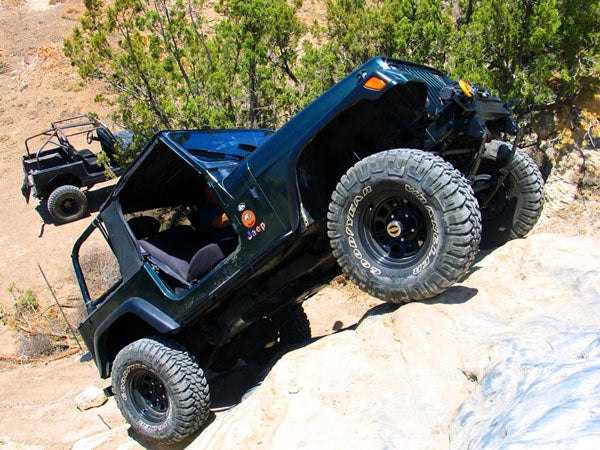 |
| Staying calm in situations like this where the Jeep is slipping off the obstacle is essential. A calm driver can easily back off this obstacle if needed where a more nervous one might mash the gas and cause the vehicle to roll. |
Stay Calm- This is easy to say while sitting behind a computer on the internet, staying calm while attempting to descend down a slope that puts you on your front bumper is a whole other matter entirely. The secret is something that can’t be taught, it just takes experience. Get as much seat time on the trail as you can, and start with gentle slopes and work your way up. Before you know it you will be ascending The Escalator in Moab without breaking a sweat.


 Your Privacy Choices
Your Privacy Choices